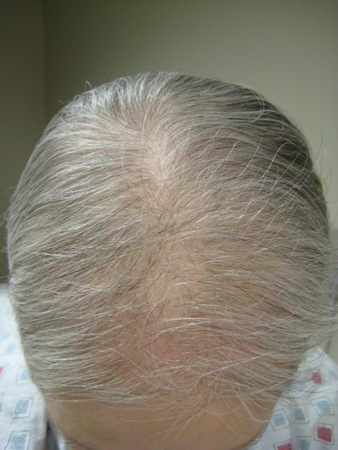A prevalência da queda de cabelo padronizada pode ser de até 98% ou apenas 40%, conforme as definições do estudo.[1]Norwood OT. Male pattern baldness: classification and incidence. South Med J. 1975 Nov;68(11):1359-65.
http://www.ncbi.nlm.nih.gov/pubmed/1188424?tool=bestpractice.com
[3]Stough D, Stenn K, Haber R, et al. Psychological effects, pathophysiology, and management of androgenic alopecia in men. Mayo Clin Proc. 2005 Oct;80(10):1316-22.
http://www.ncbi.nlm.nih.gov/pubmed/16212145?tool=bestpractice.com
[4]Gan DC, Sinclair RD. Prevalence of male and female pattern hair loss in Maryborough. J Investig Dermatol Symp Proc. 2005 Dec;10(3):184-9.
http://www.jidsponline.org/article/S0022-202X(15)52584-0/abstract
http://www.ncbi.nlm.nih.gov/pubmed/16382660?tool=bestpractice.com
[5]Rhodes T, Girman CJ, Savin RC, et al. Prevalence of male pattern hair loss in 18-49 year old men. Dermatol Surg. 1998 Dec;24(12):1330-2.
http://www.ncbi.nlm.nih.gov/pubmed/9865198?tool=bestpractice.com
Historicamente, tem-se subestimado a queda de cabelo de padrão masculino e feminino pela exclusão de seus estágios iniciais. Nos homens, o início geralmente se dá entre 20 e 25 anos e a prevalência e gravidade da doença aumentam com a idade. Em geral, 30% das pessoas brancas são afetadas na faixa dos 30 anos, 50% na faixa dos 50 e 80% aos 70 anos. A incidência global varia conforme os grupos étnicos, sendo maior na população branca, seguida pela asiática, afro-americana e indígena americana.[4]Gan DC, Sinclair RD. Prevalence of male and female pattern hair loss in Maryborough. J Investig Dermatol Symp Proc. 2005 Dec;10(3):184-9.
http://www.jidsponline.org/article/S0022-202X(15)52584-0/abstract
http://www.ncbi.nlm.nih.gov/pubmed/16382660?tool=bestpractice.com
[5]Rhodes T, Girman CJ, Savin RC, et al. Prevalence of male pattern hair loss in 18-49 year old men. Dermatol Surg. 1998 Dec;24(12):1330-2.
http://www.ncbi.nlm.nih.gov/pubmed/9865198?tool=bestpractice.com
[6]Otberg N, Finner AM, Shapiro J. Androgenetic alopecia. Endocrinol Metabol Clin N Am. 2007 Jun;36(2):379-98.
http://www.ncbi.nlm.nih.gov/pubmed/17543725?tool=bestpractice.com
Nas mulheres, o início da queda de cabelo geralmente acontece antes dos 40 anos, sendo que mais de 10% das mulheres pré-menopausa têm alguma evidência de queda de cabelo padronizada.[2]Ludwig E. Classification of the types of androgenetic alopecia (common baldness) occurring in the female sex. Br J Dermatol. 1977 Sep;97(3):247-54.
http://www.ncbi.nlm.nih.gov/pubmed/921894?tool=bestpractice.com
[7]Starace M, Orlando G, Alessandrini A, et al. Female androgenetic alopecia: an update on diagnosis and management. Am J Clin Dermatol. 2020 Feb;21(1):69-84.
http://www.ncbi.nlm.nih.gov/pubmed/31677111?tool=bestpractice.com
[8]Venning VA, Dawber RP. Patterned androgenic alopecia in women. J Am Acad Dermatol. 1988 May;18(5 Pt 1):1073-7.
http://www.ncbi.nlm.nih.gov/pubmed/3385027?tool=bestpractice.com
[9]Birch MP, Lalla SC, Messenger AG. Female pattern hair loss. Clin Exp. Dermatol. 2002 Jul;27(5):383-88.
http://www.ncbi.nlm.nih.gov/pubmed/12190638?tool=bestpractice.com
[Figure caption and citation for the preceding image starts]: Alopecia androgenética de padrão femininoDo acervo de Robert Haber, MD [Citation ends]. Entretanto, a incidência aumenta nas mulheres perto da menopausa e pode afetar 56% daquelas com mais de 70 anos de idade.[7]Starace M, Orlando G, Alessandrini A, et al. Female androgenetic alopecia: an update on diagnosis and management. Am J Clin Dermatol. 2020 Feb;21(1):69-84.
http://www.ncbi.nlm.nih.gov/pubmed/31677111?tool=bestpractice.com
Entretanto, a incidência aumenta nas mulheres perto da menopausa e pode afetar 56% daquelas com mais de 70 anos de idade.[7]Starace M, Orlando G, Alessandrini A, et al. Female androgenetic alopecia: an update on diagnosis and management. Am J Clin Dermatol. 2020 Feb;21(1):69-84.
http://www.ncbi.nlm.nih.gov/pubmed/31677111?tool=bestpractice.com
 Entretanto, a incidência aumenta nas mulheres perto da menopausa e pode afetar 56% daquelas com mais de 70 anos de idade.[7]
Entretanto, a incidência aumenta nas mulheres perto da menopausa e pode afetar 56% daquelas com mais de 70 anos de idade.[7]